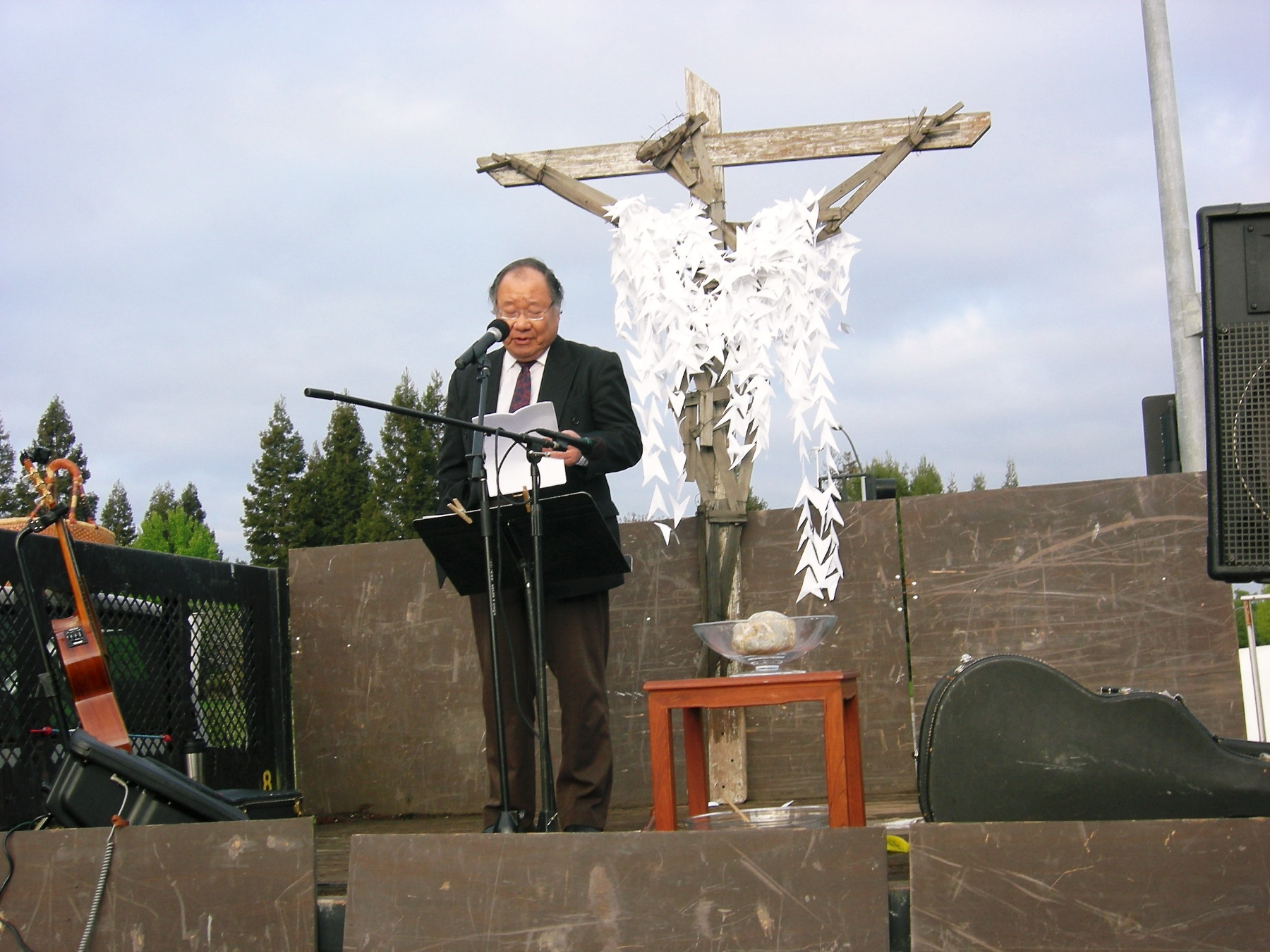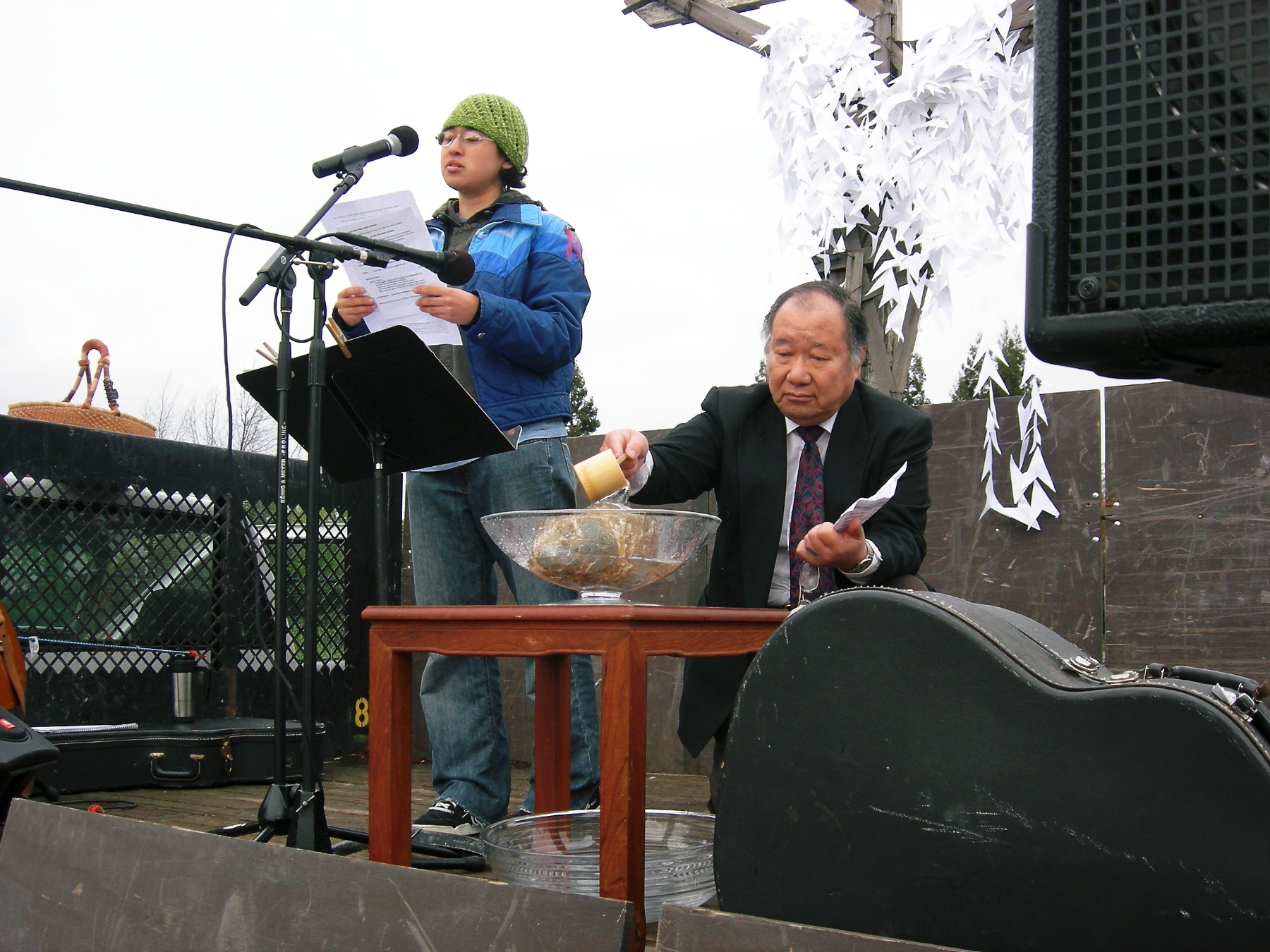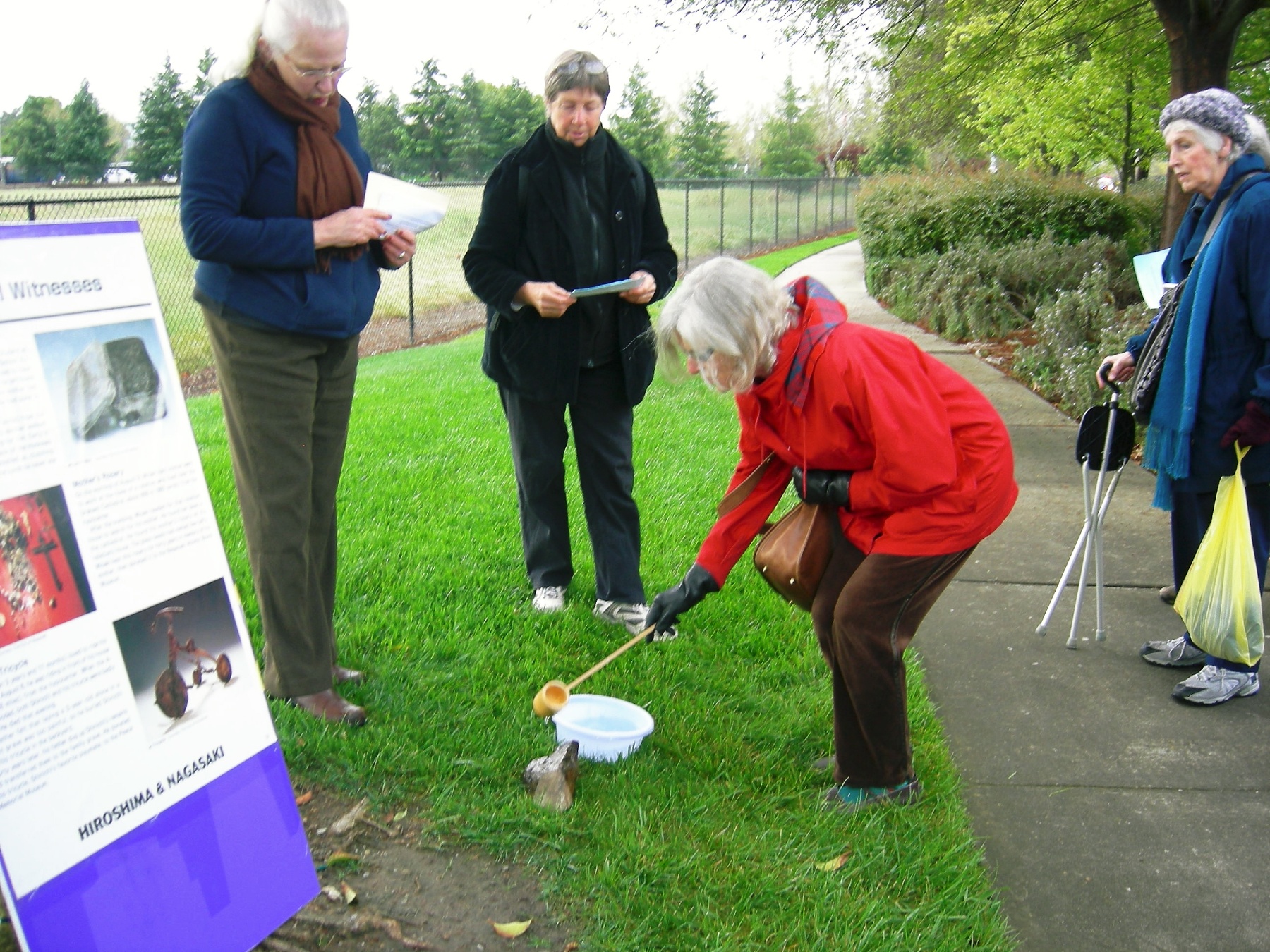|
Good Friday Service
April 10, 2009
The Rev. Nobuaki Hanaoka
Livermore Nuclear Laboratory, Livermore
 Today we commemorate the suffering death of Christ on the cross. Because we know that in the Cross is a redemption of human race and beyond Calvary awaits the dawn of a new day, we boldly acknowledge the wrong choices we have made, the wrong paths we have taken, and the sins we have committed, that brought us where we are today Therefore, my sisters and brothers, let us also be bold enough to consider the changes we must make to be accountable to God’s redeeming grace. Today we commemorate the suffering death of Christ on the cross. Because we know that in the Cross is a redemption of human race and beyond Calvary awaits the dawn of a new day, we boldly acknowledge the wrong choices we have made, the wrong paths we have taken, and the sins we have committed, that brought us where we are today Therefore, my sisters and brothers, let us also be bold enough to consider the changes we must make to be accountable to God’s redeeming grace.
As a result of the path we have taken and the choices we have made, our planet and its inhabitants are daily threatened by global climate change, mass starvation, diminishing natural resources, nuclear proliferation, ethnic cleansing, genocide, terrorism, homelessness, the unknown consequences of the war in Iraq for the Middle East and the rest of the world. Today, therefore, more than ever before, we need to renew our commitment to acknowledging the wrong and changing the ways.
We have long operated under the assumption that more is better; consuming more and accumulating more has been our aim. To that end, we have overexploited the resources of this planet, and we have fought wars to secure those depleting resources. But we have come to the point in history when we can no longer keep on living this way. Our natural resources are limited and nature’s capacity to mend itself is also limited. In the face of the dwindling fossil fuel, people are talking about turning to nuclear energy. But is turning nuclear the answer to our problems? Or will it create more problems? I believe it will.
During his presidential campaign, Senator McCain often talked about building 45 new nuclear power plants by the year 2030. He describes nuclear power as “clean and safe” alternative to oil, but is it?, Have we forgotten the partial meltdown at Three Mile Island in 1979 and the nuclear reactor explosion at Chernobyl in 1986? We don’t know the exact number of casualties in Chernobyl, but thousands are believed to have perished there. We know that the radioactive fallout encircled the Northern Hemisphere within days and at least 5 million people have been affected by the radiation. If addition to oil is bad enough, addiction to nuclear power is really bad; it can eliminate human race as we know it.
Besides, we still don’t know what to do with nuclear waste. We know there is a proposal to build a permanent Nuclear Repository in Yucca Mountain, Nevada, at the cost of over 96.2 billion dollars. O that makes us feel better, doesn’t it. Scientists have told us that the half life of uranium-238 is 4.47 billion years. Are we saying we can keep them safely stored there for billions of years? The chances of major accidents in the future are not probable, but statistical certainty. Why are we risking such disasters? Only to maintain the lifestyle we know are no longer sustainable? It is not only unethical, but insane, to say nuclear energy is safe and clean. Accidents can happen as a result of natural disasters like earthquakes, or mechanical failures or human errors. Terrorist attacks on these nuclear facilities are another real concern.
 When I talk about what happened when the first atom bombs exploded over Hiroshima and Nagasaki 64 years ago, people say why talk about what happened so long ago? George Santayana said “Those who cannot remember the past are condemned to repeat it.” That’s why; besides, to those who survived the nuclear bombs 64 years ago, it is not even the past: many are still struggling to survive it. Today, the people of Uyghur When I talk about what happened when the first atom bombs exploded over Hiroshima and Nagasaki 64 years ago, people say why talk about what happened so long ago? George Santayana said “Those who cannot remember the past are condemned to repeat it.” That’s why; besides, to those who survived the nuclear bombs 64 years ago, it is not even the past: many are still struggling to survive it. Today, the people of Uyghur ancestry in the Xinjiang district in China are dying as a result of the repeated nuclear weapons test there. The people of Martial Islands are still struggling to survive as a result of our weapons tests there. It is not about the past, but the present. ancestry in the Xinjiang district in China are dying as a result of the repeated nuclear weapons test there. The people of Martial Islands are still struggling to survive as a result of our weapons tests there. It is not about the past, but the present.
On August 6, 1945, the first atom bomb was dropped on Hiroshima, and three days later on Nagasaki. I was born on December 25, 1944 in Nagasaki, which means I was only 7 months old. Because I was only a baby, I have no recollection of the bombing. But I have since learned that the nuclear explosions over Hiroshima and Nagasaki unleashed unprecedented amounts of destructive energy. First, it came as a blast. The sudden expansion of air produced the 800 mph wind, which crushed most of the buildings within one mile radius. It was followed by the tremendous heat equivalent to that on the surface of the sun. The heat either ignited or vaporized just about everything within one mile radius, causing the citywide fire within seconds. People, animals and vegetation near the epicenter instantly vaporized. The blast and the fire combined destroyed almost 90% of the buildings in the city of Hiroshima. 120,000 were killed instantly by the blast and the heat. The survivors of Hiroshima and Nagasaki remember vividly the processions of the ghostly figures, with their skin dangling, red eye balls bulging, begging for water in weak voices, as they were burnt and dehydrated. It has since become a tradition in Japan and elsewhere to offer them water to quench their thirst. The last words of Christ on the cross were “I thirst.” I feel as though Christ on the cross joined the victims of the thermo-nuclear warfare. Friends, we are all survivors, we have made it so far. So, we all thirst for peace. And so we offer the water of peace to all others who thirst for peace and justice today.
The destruction was massive in both Hiroshima and Nagasaki, but the most feared effects of the nuclear bombs came later in the form of invisible, radioactive particles released into the atmosphere. After the explosion, the rain quietly fell over the wide areas. It was called “black rain” because it contained dark ashes from the explosion. It was contaminated with highly radioactive particles. The black rain collected into the city reservoirs and those who survived the initial blast and the heat drank from it to quench their thirst. Due to the radioactive fallout, by the end of 1950, the casualties reached a quarter of a million deaths and the radiation has since killed more. Radiation goes into your bone marrow and destroys your immune system, making you susceptible to all kinds of diseases, including cancers. I hear the survivors say, “Those who were killed in the blast were the lucky ones because they were spared from all these sicknesses and slow deaths.”
Near the epicenter of the explosion in Nagasaki was the largest Christian church in Asia, the Urakami Catholic Church. Of the 12,000 members of that church, 8,500 vaporized that day, and those who survived suffered from radiation sickness for many years. Since our home was not close to the epicenter of the explosion, we were not affected by the blast or the fire, but we were all exposed to radiation through the water we drank and the air we breathed. Soon after the war ended, my mother got sick and my sister was also diagnosed with leukemia. As far back as I can remember, both my mother and my sister were always sick in bed. When I was six, my mother finally died. My sister followed her soon afterwards. The nuclear weapons kill people indiscriminately. The radiation kills people indiscriminately.
How did those horrific weapons come to be?
When they found that German scientists were developing deadly new weapons using nuclear reactions, Albert Einstein and other physicists wrote to President Roosevelt that the US should produce nuclear bombs before Germans succeeded in it. In response to the scientists’ plea, the massive Manhattan Project was begun in the summer of 1942. Under the leadership of Dr. Robert Oppenheimer, the bombs successfully tested in three short years. They created two types of bombs, one using the fission of uranium-238, and the other using the plutonium, a byproduct of uranium enrichment. When Hitler’s army had been defeated in Europe, many scientists pleaded to stop the production of the atom bombs because there was no reason to continue developing such weapons of mass destruction, but the project continued. Japan was already considering the terms of surrender, and had the feelers out. The end of the war in the Pacific theater appeared imminent. But when Russia declared war against Japan, the US needed to keep Russia our of Asia by demonstrating to the Russians the power of the ultimate weapon the US had developed. The US was successful in keeping Russia out of the Pacific, but the world had to pay a very high price for that. When the Soviet Union saw the power of the atom bombs, Stalin felt his country had to defend itself from the American nuclear aggression and ordered to accelerate its own nuclear program. In four years, the Soviet Union successfully tested its first nuclear bomb. To respond to it, the US created a hydrogen bomb, which was much more powerful than atom bombs. The Hiroshima and Nagasaki bombs were only 20 kilotons of TNT, but the new Hydrogen bomb was ten megatons. The scientists, including Einstein and Oppenheimer, passionately objected to the development of such bombs, calling it a weapon of global genocide. The US administration ignored the plea and continued its program. The US nuclear supremacy did not last very long, however, as the Soviet Union successfully tested their first Hydrogen bomb a year later. The nuclear race thus began between the US and the Soviet Union, and within a few years, the United Kingdom, France and China joined the club. Because China had it, India had to have its own. When India had it, Pakistan had to have its own. to have its own.
The United States maintained that the US nuclear program would deter further nuclear escalation. But, it has become clear that it does not deter it, but encourages it.
After the Cuban missile crisis, realizing how close the world had come to nuclear annihilation, President John F. Kennedy proposed to the United Nations a Comprehensive Test-Ban Treaty, and in 1968, President Johnson signed the Nuclear Non-Proliferation Treaty. When it went into effect in 1970, 128 nations had pledged never to seek nuclear weapons, and those who already had nuclear weapons pledged to reduce and eventually eliminate their nuclear weapons program. India, Pakistan, and Israel did not join the treaty, and North Korea later left the treaty. The UN also formed the International Atomic Energy Agency (IAEA) to monitor and regulate the development of nuclear energy, both military and peaceful use.
Thanks to the Nuclear Non-Proliferation Treaty, most of the states that had had a nuclear weapons program have abandoned it except for 9 nations, including the United States, Russia, and China. Thanks to the subsequent treaties, our stockpiles have been reduced to less than one half of what it used to be, but it does not mean the nuclear threat is over. Today, the US still has ten thousand nuclear arsenals, equivalent of 150,000 Hiroshima-size bombs. The maintenance of those weapons and their delivery systems alone is costing the US taxpayers 17.6 billion dollars every year. We have long demanded other nations to comply with the Non-Proliferation Treaty, while we were maintaining and improving our own nuclear weapons program at such facilities as Livermore Nuclear Lab. If we expect other countries to abide by the treaty, shouldn’t we also make good on the promise we made?
To reduce the possibilities of accidents, human errors, or theft, we must immediately and dramatically reduce the number of nuclear arsenals, and work toward their complete elimination. At the same time, we must reject reliance on nuclear power altogether and work toward developing sources of renewable energy in a sustainable way. At the same time, our pulpits should be preaching a new value system, less is better, sharing, rather than competing, is better. There is no pride in military supremacy, but in moral leadership. Let us leave to our posterity a nuclear-free, safe and peaceful world. Let us rise with Christ come Easter and begin to live a new life as responsible stewards of God’s beautiful creation.
|
